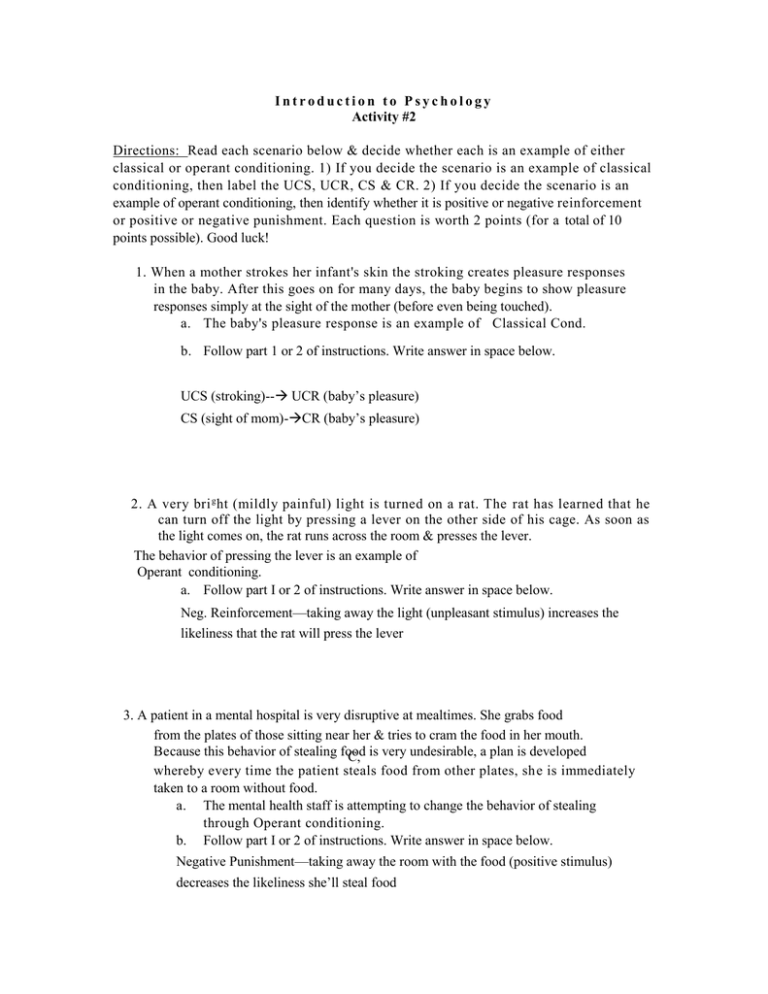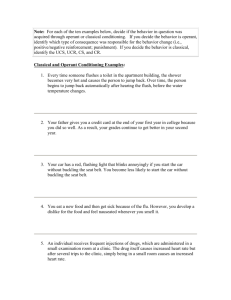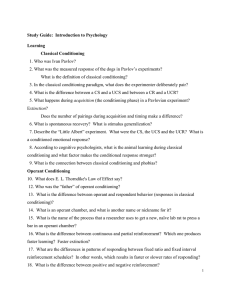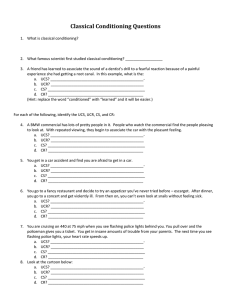Activity #2 Key
advertisement

Introduction to Psychology Activity #2 Directions: Read each scenario below & decide whether each is an example of either classical or operant conditioning. 1) If you decide the scenario is an example of classical conditioning, then label the UCS, UCR, CS & CR. 2) If you decide the scenario is an example of operant conditioning, then identify whether it is positive or negative reinforcement or positive or negative punishment. Each question is worth 2 points (for a total of 10 points possible). Good luck! 1. When a mother strokes her infant's skin the stroking creates pleasure responses in the baby. After this goes on for many days, the baby begins to show pleasure responses simply at the sight of the mother (before even being touched). a. The baby's pleasure response is an example of Classical Cond. b. Follow part 1 or 2 of instructions. Write answer in space below. UCS (stroking)-- UCR (baby’s pleasure) CS (sight of mom)-CR (baby’s pleasure) 2. A very bri g ht (mildly painful) light is turned on a rat. The rat has learned that he can turn off the light by pressing a lever on the other side of his cage. As soon as the light comes on, the rat runs across the room & presses the lever. The behavior of pressing the lever is an example of Operant conditioning. a. Follow part I or 2 of instructions. Write answer in space below. Neg. Reinforcement—taking away the light (unpleasant stimulus) increases the likeliness that the rat will press the lever 3. A patient in a mental hospital is very disruptive at mealtimes. She grabs food from the plates of those sitting near her & tries to cram the food in her mouth. Because this behavior of stealing food C, is very undesirable, a plan is developed whereby every time the patient steals food from other plates, she is immediately taken to a room without food. a. The mental health staff is attempting to change the behavior of stealing through Operant conditioning. b. Follow part I or 2 of instructions. Write answer in space below. Negative Punishment—taking away the room with the food (positive stimulus) decreases the likeliness she’ll steal food 4. Tommy has developed a habit of yelling "Bye, Mom' & then slamming the door very loudly in his hurry to leave for school in the morning. The door slam causes the mother to flinch. After several days of the procedure, Tommy's mother begins to flinch at the sound of her son's words, "Bye Mom". a. ___________ The mother's flinching behavior can be explained through Classical conditioning. b. Follow part 1 or 2 of instructions. Write answer in space below. UCS (door slam) UCR (mom flinches) CS (son yelling “bye mom”) CR (mom flinches) 5. Imagine you have a friend who keeps the temperature in her home so high that each occasion on which you visit her you find yourself perspiring. The last time you visited her, you noticed that you began to perspire & became uncomfortable as soon as you saw her house (before you were even inside). a.Your perspiring behavior can be explained as Classical conditioning. b.Follow part 1 or 2 of instructions. Write answer in space below. UCS (high temperature in house) UCR (sweating) CS (sight of friend’s house) CR (sweating)





